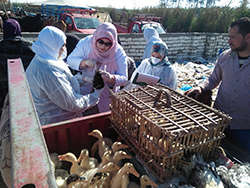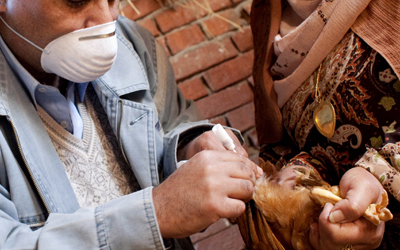
1) Early detection of H5N8 HPAI in 2016
A/H5N8 HPAI has been witnessing an upsurge in the number of detections recorded globally since October 2016. ECTAD hand in hand with GOVS accordingly intensified the AI surveillance activities in domestic birds around flyways of migratory birds and supported in improving the laboratory preparedness for the early detection and rapid response to any emerging sub-type.
The activities conducted to strengthen early warning on the field and laboratory levels led to the early detection of H5N8 HPAI on 29 November 2016 in migratory birds (common coot) at a fish market in Damietta before spreading to the domestic sector. This was coupled with the improved capacity of laboratories in announcing the results with complete identification within 48 hours. In addition to that, the policy and legislation to regulate the hunting and trading of migratory birds were updated following the H5N8 detection.
2) Early detection of H5N2 HPAI in 2018
The surveillance program continued its role as an early warning tool in 2018 when the first reassortant strain H5N2 was detected in a commercial duck farm. A/H5N2 is a reassortment between two Egyptian circulating strains: the H5 gene from highly pathogenic H5N8 and the N2 gene from the low pathogenic H9N2 virus.
The detection phase was followed by an ad hoc effective rapid response including culling, disposal, decontamination, and ring vaccination which played a substantial role in limiting the potential spread of the new emerging strain.

